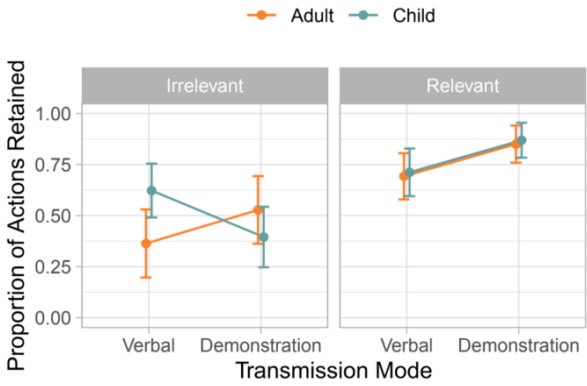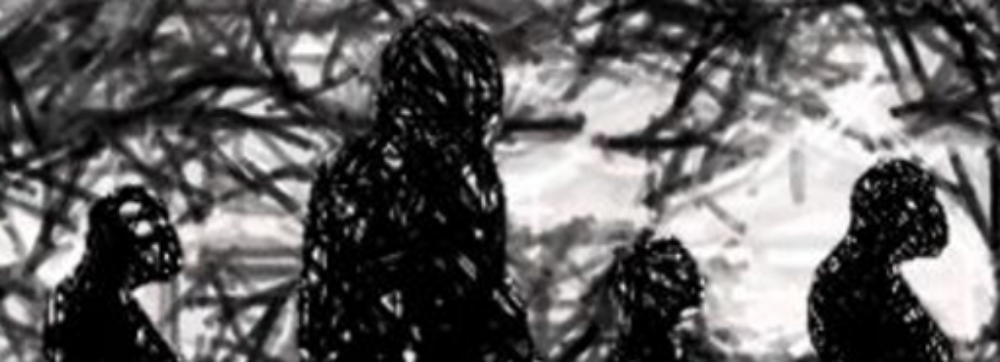Aliki Papa, Mioara Cristea, Nicola McGuigan and Monica Tamariz
Cultural transmission and evolution depend crucially on copying fidelity [1]. Humans tend to overimitate: they not only copy causally-relevant actions, which contribute to achieving a goal, but also causally-irrelevant actions, which do not contribute [2-5]. We know that adding verbal input to observational, visual modelling improves copying fidelity for complex tasks [5]. However, we do not know how linguistic and visual input independently contribute to copying actions. By investigating this question, the present study suggests a possible functional factor posing selection for the evolution of language, as language would have been adaptive because it enhanced the fidelity of cultural transmission.
In this first direct, systematic comparison of demonstration vs language-based social learning, we measured the transmission fidelity and cumulative improvement of an action sequence whose objective was to extract a reward from a box.
120 participants were organised in 40 transmission chains, and each of them either watched a model demonstrate an action sequence or listened to verbal instructions to produce the action sequence. In order to explore imitation and overimitation, the sequences included actions that were causally relevant or irrelevant, respectively, to extracting the reward. We explored these effects on transmission in 20 adult chains and in 20 chains of 6 to 8-year-old children. A control group interacted with the box to determine which actions were performed spontaneously.
Apart from expected results that relevant actions are copied more than irrelevant actions, we found a significant 3-way interaction between transmission mode, relevance and age (figure 1): Adults overimitate more in Demonstration than in Verbal Instructions, Children overimitate more in Verbal instructions than in Demonstration, Adults overimitate more than Children in Demonstration, and, most importantly, Children overimitate more than Adults in Verbal instructions.

Our results show that, amongst children, language leads to overimitation and, therefore, high fidelity transmission of behaviour. Cumulative cultural evolution produces sophisticated, complex behaviour whose function may not be obvious. By promoting the retention of behaviour even when its function is not understood, specifically in children, language may play a supportive role in cumulative cultural evolution.
References
[1] Tennie C, Call J, Tomasello M. Ratcheting up the ratchet: on the evolution of cumulativeculture. Philosophical Transactions of the Royal Society B: Biological Sciences. 2009 Aug 27;364(1528):2405-15.
[2] McGuigan N, Whiten A, Flynn E, Horner V. Imitation of causally opaque versus causally transparent tool use by 3-and 5-year-old children. Cognitive Development. 2007 Jul 1;22(3):353-64.
[3] McGuigan N, Makinson J, Whiten A. From over‐imitation to super‐copying: Adults imitate causally irrelevant aspects of tool use with higher fidelity than young children. British Journal of Psychology. 2011 Feb 1;102(1):1-8.
[4] Nielsen M, Mushin I, Tomaselli K, Whiten A. Where culture takes hold:“Overimitation” and its flexible deployment in Western, Aboriginal, and Bushmen children. Child development. 2014 Nov;85(6):2169-84.
[5] Whiten A, Allan G, Devlin S, Kseib N, Raw N, McGuigan N. Social learning in the real-world:‘Over-imitation’occurs in both children and adults unaware of participation in an experiment and independently of social interaction. PloS one. 2016 Jul 28;11(7):e0159920.
[6] Morgan TJ, Uomini NT, Rendell LE, Chouinard-Thuly L, Street SE, Lewis HM, Cross CP, Evans C, Kearney R, de la Torre I, Whiten A. Experimental evidence for the co-evolution of hominin tool-making teaching and language. Nature communications. 2015 Jan 13;6:6029.
